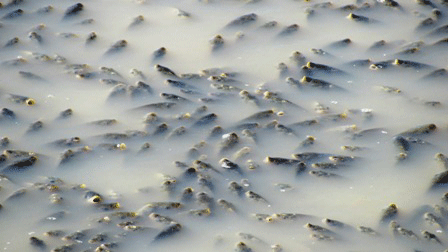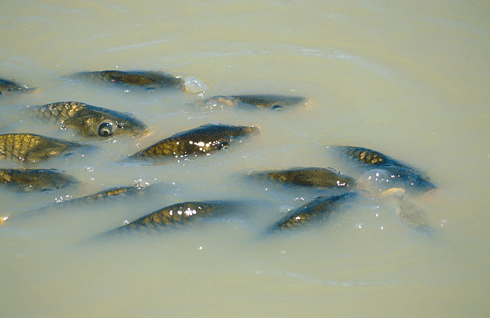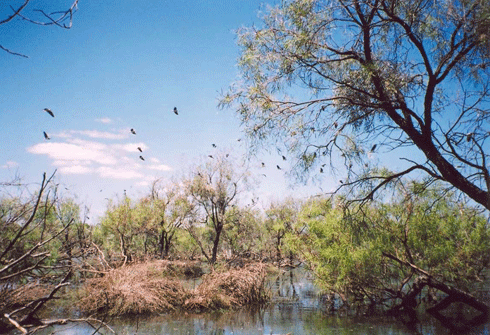
|
Published: 27 March 2012
Carp herpesvirus could stem the tide
While two years of flooding rains have brought our river systems back to life, populations of carp – previously held in check by the drought – have exploded. This will likely have dire consequences for our waterways and native wildlife. A recently identified biological control agent may one day keep carp numbers in check.

|
|
Baby carp aggregated below the Menindee main weir, Darling River, NSW, 2011.
Credit: Nigel Harris/NSW Office of Water
|
European carp (Cyprinus carpio) was first introduced to Australian waterways more than 100 years ago and is now established in every state except the Northern Territory. Able to tolerate a wide range of conditions and habitats, including low-oxygen and brackish water, they are considered one of the country’s major aquatic pests.
‘While they don’t prey on native fish, they indirectly impact them by being able to multiply very quickly to better exploit their environment through their greater numbers,’ explains fish biologist Wayne Fulton, who works on carp control at the Invasive Animals Cooperative Research Centre (CRC).
Geoff Hall, a professional fly fishing guide and past president of the Australian Trout Foundation, agrees.
‘Carp are the cane toads of the aquatic environment,’ he says.
‘They are incredibly dangerous to other organisms, because they raise sediment by sucking detritus from the bottom and filtering it, which eliminates sunlight, and cuts out macrophytes or aquatic plants.
‘This suits carp, but turns pristine, clean waterways into turgid, turbid, polluted messes. [This] could be the future of all waterways, unless we stop them.’
Biological control agent shows promise
A suite of research projects by the Invasive Animals CRC have – among other things – identified the fish’s favourite breeding grounds and led to the development of carp-specific traps. However, the CRC’s identification of a biological control agent holds the most hope for stopping the carp’s spread.
The agent is Koi herpesvirus (KHV), or Cyprinid herpesvirus 3 (CyHV-3). This highly contagious water-borne disease first appeared in Israel in 1998 and spread rapidly to other parts of the world, including Japan, Indonesia and North America. It is specific to C. carpio, fast-acting, and kills 70–100 per cent of infected fish.
‘Fish become infected after just a few seconds’ contact with a carrier, with death occurring within a few days of exposure,’ says Mr Fulton.
Undertaken at CSIRO’s Australian Animal Health Laboratory and funded by the Invasive Animals CRC, the KHV research aims to ensure that the virus does not affect Australian native species. So far, Murray cod and silver perch (or golden perch) have been given the all-clear.
The way the disease is transmitted and likely to spread is also under investigation, as is the effect of environmental conditions (e.g. changes in water temperature) on KHV’s potency.
‘We know from our experience with rabbit haemorrhagic disease that cross-reactions with other viruses can potentially reduce its effectiveness in certain circumstances,’ adds Mr Fulton.
‘So, we are investigating its reaction to any other related viruses that may already be present in Australia, such as other cyprinid herpesvirus, CyHV-1 (carp pox) or CyHV-2 (goldfish haematopoietic virus).’

|
|
Carp outcompete native fish not just through their prolific breeding, but through their ability to exploit a range of freshwater environments.
Credit: G. Heath/scienceimage
|
Currently, KHV is scheduled for release into Australian waterways in 2017, subject to the approval of the Australian Pesticides and Veterinary Medicines Authority (APVMA).
Recreational fishers welcome the prospect.
‘We are cautiously optimistic about KHV and would certainly like to think that this is a solution to the problem of exploding carp numbers in the Murray–Darling Basin area,’ says Christopher Collins, Executive Officer of the Victorian Recreational Fishing Peak Body.
Victorian trout angler, Mr Hall, would like to see the tests and approvals expedited so that the virus could be released earlier. He has been seeing carp moving steadily upriver towards Lake Eildon.
‘We need to act quickly, or we will have another environmental disaster on our hands,’ he warns.
|
Led by Dr Ken McColl, a team at CSIRO’s Animal Health Laboratory is undertaking rigorous tests to determine KHV’s suitability for use as a biological control agent and meet due diligence obligations before its release. |
The laboratory-based studies include: |
examining the susceptibility of carp at different ages and sizes |
screening Australian carp in the wild for other cyprinid herpesviruses, CyHV-1 or CyHV-2 |
determining the level, if any, of cross-protection that exposure to these viruses may confer on wild carp populations. |
Researchers have also been developing models that simulate the release of KHV in a wild carp population to predict the virus’ effectiveness, rate of spread and persistence, as well as how the hydrodynamics of different river systems might affect these factors. |
Once these studies are completed and KHV’s effectiveness as a biological control agent is verified, an extended public consultation phase will be undertaken, with the virus’s final release date subject to APVMA approval. |
In an announcement late last year, the Invasive Animals CRC said the release of the virus would be focused on carp spawning ‘hotspots’ to maximise impact. CRC-funded research has identified 18 such hotspots in the Murray–Darling Basin, as well as another nine areas with habitat features suggesting they may act as carp hotspots when flooded. |
Seven of these 27 hotspots produce very high numbers of juvenile carp. These include the Macquarie Marshes, Namoi wetlands, Gwydir wetlands and Barmah-Millewa Forest. Release of the virus into such carp ‘nurseries’ would be particularly effective, as young carp are more susceptible to the virus than adult fish. |

Straw-necked ibis nesting near the Gingham Watercourse in NSW’s Gwydir wetlands – an environmentally significant habitat that is also a carp nursery hotspot. Credit: Liz Savage/Tara Schalk/DECCW
|



